
Dendera [Dandara]. Dec. 7th, 1838.
A hand-painted replica of David Roberts’s masterpiece Dendera [Dandara]. Dec. 7th, 1838., meticulously crafted by professional artists to capture the true essence of the original. Each piece is created with museum-quality canvas and rare mineral pigments, carefully painted by experienced artists with delicate brushstrokes and rich, layered colors to perfectly recreate the texture of the original artwork. Unlike machine-printed reproductions, this hand-painted version brings the painting to life, infused with the artist’s emotions and skill in every stroke. Whether for personal collection or home decoration, it instantly elevates the artistic atmosphere of any space.
David Roberts' artwork "Dendera [Dandara]. Dec. 7th, 1838" is a notable piece from his extensive collection of lithographs and paintings that document his travels in Egypt and the Near East. Roberts, a Scottish painter born in 1796, is renowned for his detailed and picturesque representations of ancient sites and monuments. His works are significant for their historical and artistic value, capturing the essence of 19th-century exploration and interest in the ancient world.
The painting "Dendera [Dandara]. Dec. 7th, 1838" depicts the Temple of Dendera, one of the best-preserved temple complexes in Egypt. Located near the city of Qena, the temple is dedicated to Hathor, the ancient Egyptian goddess of love, beauty, and music. The temple complex is a testament to the architectural prowess of the Ptolemaic period, with its construction beginning in the late Ptolemaic Dynasty and continuing into the Roman period.
Roberts visited Egypt as part of his grand tour of the Middle East from 1838 to 1839. During this journey, he produced numerous sketches and studies that would later be transformed into lithographs by Louis Haghe, a prominent Belgian lithographer. These lithographs were published in a series titled "The Holy Land, Syria, Idumea, Arabia, Egypt, and Nubia," which gained widespread acclaim for their accuracy and artistic quality.
In "Dendera [Dandara]. Dec. 7th, 1838," Roberts captures the grandeur of the temple's architecture. The artwork likely features the temple's massive stone columns, intricately carved with hieroglyphics and images of deities, which are characteristic of the site. The hypostyle hall, a common feature in Egyptian temples, is one of the architectural highlights that Roberts might have depicted. This hall is known for its forest of columns and the richly decorated ceiling, which features astronomical scenes.
Roberts' work is not only an artistic achievement but also an important historical document. His paintings and lithographs provide a visual record of the state of these ancient sites in the 19th century, before the extensive archaeological excavations and restorations of the 20th century. They offer insights into the condition and appearance of these monuments at a time when photography was not yet widely available.
The significance of Roberts' work extends beyond its artistic merit. It played a crucial role in sparking European interest in Egyptology and the study of ancient Egyptian culture. His detailed and romanticized views of ancient sites contributed to the fascination with Egypt that characterized the 19th century, influencing both scholarly research and popular culture.
"Dendera [Dandara]. Dec. 7th, 1838" is a reflection of Roberts' skill in capturing the essence of ancient architecture and his dedication to documenting the cultural heritage of the regions he visited. His works remain valuable resources for historians, archaeologists, and art enthusiasts alike, offering a glimpse into the past through the eyes of a 19th-century traveler and artist.





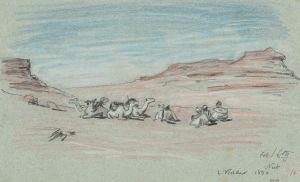
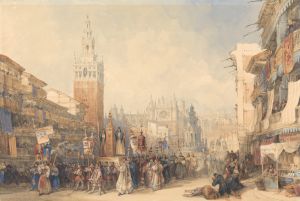

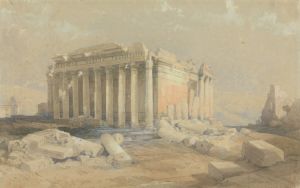
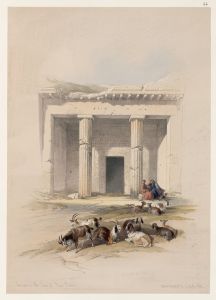

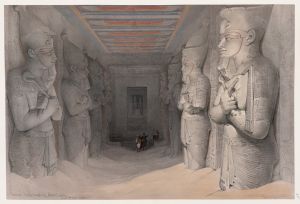

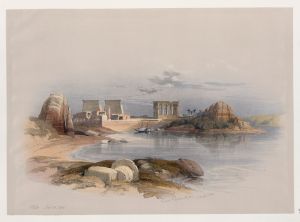
![Portico of the Temple of Edfou [Idfû], Upper Egypt. Nov. 23rd, 1838.](/imgs/217527/s/david-roberts-portico-of-the-temple-of-edfou-idfu-upper-egypt-nov-23rd-1838-79b6cf5b.jpg)
![Portico of the Temple of Kalabshi [Kalâbishah].](/imgs/217528/s/david-roberts-portico-of-the-temple-of-kalabshi-kalabishah-3a295995.jpg)
![Temple of Edfou [Idfû], ancient Appolinopolis, Upper Egypt.](/imgs/217546/s/david-roberts-temple-of-edfou-idfu-ancient-appolinopolis-upper-egypt-2a77d2d6.jpg)
![View on the Nile looking towards the pyramids of Dashour [Dahshûr]and Saccara [Saqqârah].](/imgs/217572/s/david-roberts-view-on-the-nile-looking-towards-the-pyramids-of-dashour-dahshurand-saccara-saqqarah-6cb692fe.jpg)